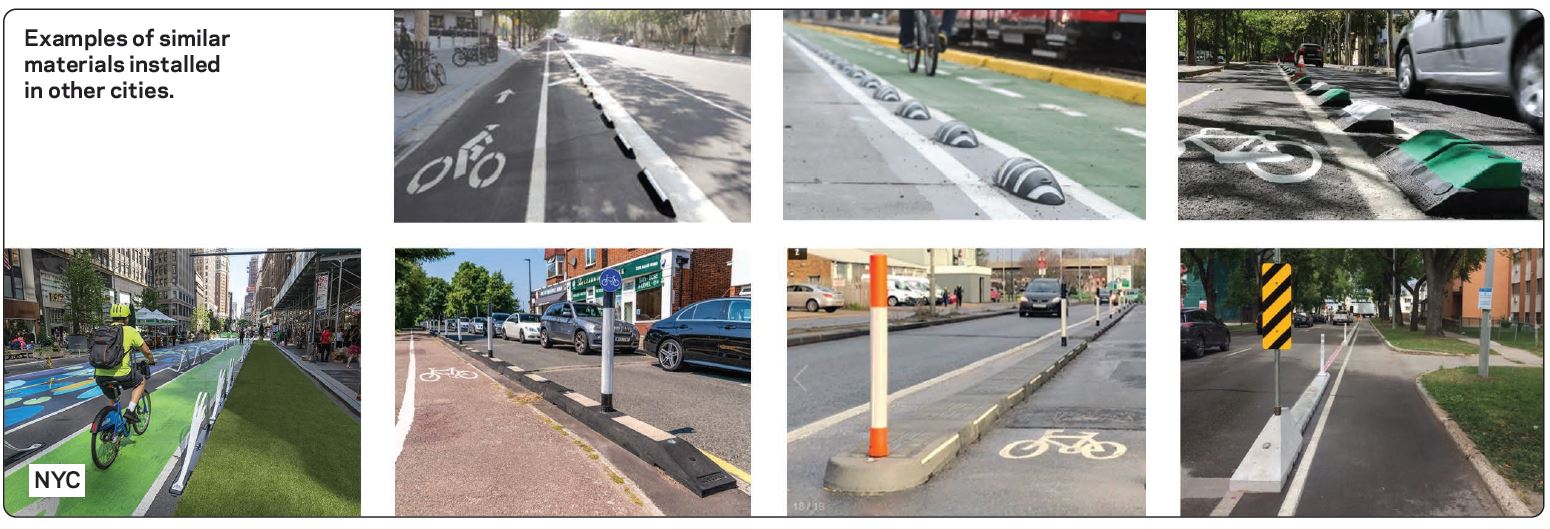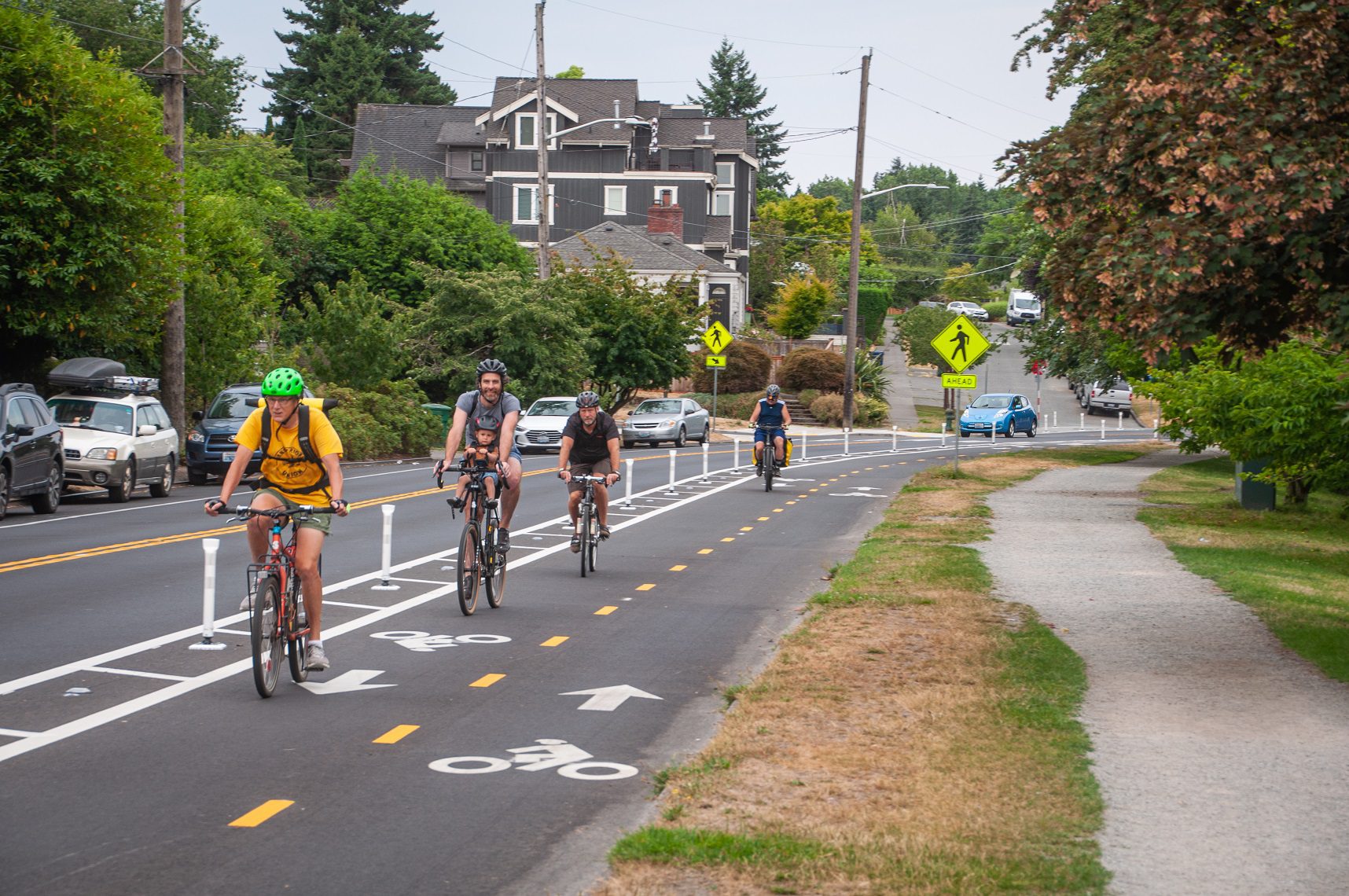As cities move to reduce pollution, draw down their emissions, and create safer streets, there is no better investment for their infrastructure dollars than protected bike lanes. This simple solution eliminates emissions, improves commute times, reduces congestion, and increases personal freedom–all without breaking the bank.
Vehicles Are The Largest Source of Emissions Within Cities
In urban environments, the largest single source of CO2 emissions is the combustion of fossil fuels in cars, trucks, and buses. As cities seek to lower the carbon footprint of moving people around, they often invest in light rail, electrified buses, and charging stations. But in the race to eliminate emissions, more drastic steps are needed.
While expanding public transit plays a crucial role in lowering emissions, most often it isn’t enough. In much of the United States, fixed routes and resource constraints limit transit’s frequency and availability. This inconvenience explains why those who can afford to own a car or take an Uber or Lyft will choose that option. The result: an income gap between those who take public transit and those who do not.
The most livable cities of the future will be oriented around people, not cars. In addition to vibrant public spaces and walkable neighborhoods, these cities will provide a network of connected and protected lanes for short commutes and ample public transit and EV chargers for longer commutes.
Protected Lanes Boost Ridership, Cut Emissions, and Improve Traffic for Cars
In Copenhagen, for example, there are 237 miles of bike lanes, most of which are elevated or physically separated from car traffic by a curb. In 2018, 49 percent of all commuter trips–and 28 percent of all trips–in the city were made by bike. By contrast, barely 1 percent of commuter trips in New York City and 4 percent of trips in San Francisco involved a bicycle.
While cars emit almost a pound of CO2 per mile traveled from their tailpipes, bikes produce none at all. Switching from taking a car to riding a bike immediately cuts carbon dioxide emissions within a city. We cannot afford to wait for the EV revolution. Given the twelve-year lifespan of an average car, the transition to zero-emission vehicles will take more than two decades. Cities need to implement solutions that tackle the emissions crisis today.
Let’s be honest; commuting can be a horrific experience. In big cities around the world, traffic grinds to a halt at rush hour. In New Delhi, you can outwalk traffic. Austin slows to 6 miles per hour, Los Angeles to 8 miles per hour. On the other hand, bike riders’ average rush hour speed is 9 miles per hour. As bikes are smaller than cars, a greater volume of them can move through the same space at higher speeds during traffic jams.
Adding bike lanes doesn’t have to slow down car traffic. When New York City added a six-foot buffered bike lane by narrowing each lane in a handful of corridors, they found that car volumes were unaffected–and that those cars moved 35 percent faster. Space for on-street parking was often preserved as well. Cities don’t have to choose between creating bike lanes and improving traffic flow—they really can have it all.
Safety is the Biggest Barrier to Cycling Adoption
Unfortunately, without dedicated lanes that physically separate bicycle traffic from cars and pedestrians, cycling will never feel safe enough for mass adoption. Adding buffers–posts, planters, or curbs–makes people far more comfortable biking on streets. Painted lanes are not enough. When a national survey asked residents why they didn’t bike, they identified separated, protected bike lanes as a key missing element. Nearly two-thirds of residents said they “would be more likely to ride a bicycle if motor vehicles and bicycles were physically separated by a barrier.” Take Seville, Spain, which saw a fivefold increase in cycling when the city added 74 miles of new and dedicated bike lanes.

When lanes are not protected, cyclists are left to navigate an obstacle course of cars turning in front of them or pulling out or pulling in. When lanes are simply painted, they are often ignored and used for cars and trucks to load or unload, forcing bike riders to cross into traffic. These lanes are often adjacent to parked cars, whose opening doors account for up to 27 percent of car-bike collisions in cities. A shared road is still a road designed primarily for cars.
Cyclists are six times more likely to die in the United States than in Germany, the Netherlands, or Denmark, where protected cycling infrastructure is the norm. Optimizing for cyclist safety leads to significant increases–sometimes double or more—in new and existing riders. It also leads to a 44 percent reduction in cyclist fatalities and a 50 percent reduction in injuries.
These are data points and conclusions from research from around the world. But what does your gut say? Would you let your eight-year-old ride a bicycle in a city with only painted lanes? Would you let your 80-year-old parent? Of course not. If a city wants to increase cycling and reduce carbon emissions, it needs to offer cyclists an end-to-end network of protected lanes.
A Win for Mayors, Local Officials, and the Community
To counteract the trend of increasing car ownership, cities need to take action before it is too late. In a recent survey of millennials, nearly a third who did not own a car said they planned to buy one soon. Only 6 percent said they would be purchasing a purely electric vehicle. No amount of light rail or buses can turn this tide. For a city to do battle with the perceived safety and autonomy of cars, it needs to carve out more room on roadways for cyclists.
###
Need assistance? Between November 10, 2022 to February 3, 2023, Bloomberg Philanthropies will be funding grants of $400K to $1M to cities with ambitious cycling infrastructure projects. Learn more at the Bloomberg Initiative for Cycling Infrastructure.
Image Credits: Seattle Department of Transportation and New York Department of Transportation




